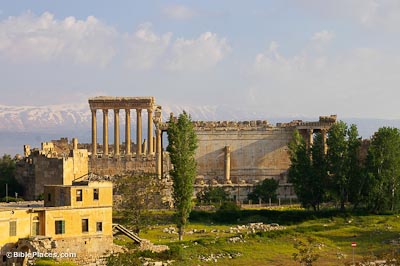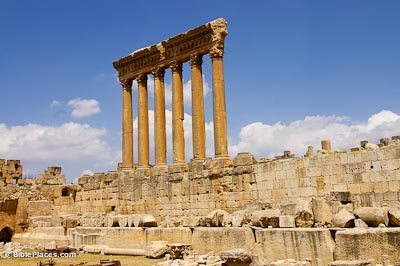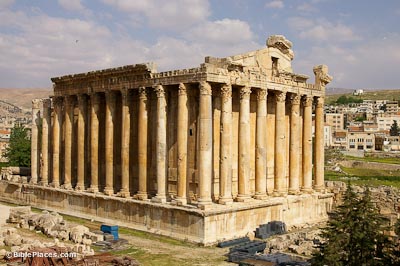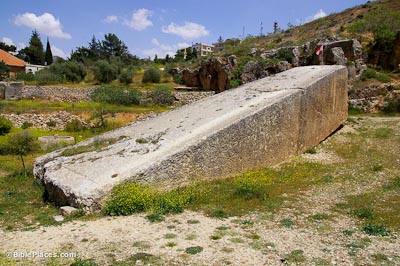Baalbek is the site of Roman temples located in the Beqa plain, situated near the watershed between the Litani River which drains to the south and the Orontes River which drains to the north. This was an earlier cult center for deities which were later identified by the Romans with Jupiter, Mercury, and Venus. The Roman temples are oriented approximately on an east-west axis with the entrances facing the east.
Baalbek

Baalbek Temples
Temple of Jupiter
Six original columns of the Temple of Jupiter are still standing with their entablature. They are 65 feet (20 m) tall and 8.2 feet (2.5 m) in diameter. In the 18th century, there were reports of nine columns that were standing, but the earthquake in 1759 toppled three leaving the six that are seen today.


Temple of Bacchus
The Temple of Bacchus was built in the 2nd century AD by the Roman emperor Antoninus Pius, but it was still incomplete when Constantine the Great closed the temples at Baalbek. The Bacchus Temple is the best-preserved Roman temple in the entire Middle East.
Stone of the Pregnant Woman
A Roman quarry is located about a half-mile (1 km) south of the temples. A massive stone, known locally as Hajjar el-Hibla (“Stone of the Pregnant Woman”), remains in the quarry still attached to bedrock. It is larger than the stones used in the construction of the Temple of Jupiter. It measures 65.5 feet (20 m) in length, 13 feet (4 m) in width, and 13 feet (4 m) in height, and weighs over 1,000 tons (900 t).


Download all of our Lebanon photos!
$34.00 $49.99 FREE SHIPPING
Related Websites
For historical images of Baalbek, the Temple of Bacchus, Baalbek’s temple courts, and the Temple of Jupiter, see Life in the Holy Land.
Heliopolis (Baalbek) (Livius) This page walks through the site’s history. It also has several photos of the site and related artifacts.
Baalbeck (MiddleEast.com) Offers general information about Baalbek and describes its major points of interest.
Mystery of the stones: How Lebanon’s Baalbek ruins are a site for the gods (Middle East Eye) This well-illustrated article has an interesting section discussing the site’s modern history.
Baalbek Trilithon (Atlas Obscura) An article focusing on Baalbek’s famous stone.
Baalbek (World Pilgrimage Guide) This article features quite a comprehensive history of the site, along with a number of photos.
Ruins of Palmyra and Baalbek (YouTube) This short film from 1938 is fascinating both for its old footage of the sites and for its sometimes odd historical assertions.